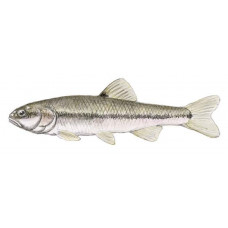Latin name
Squalius cephalus
Other names
Common chub, European chub, squalius cephalus.
Identification
River chub is an olive-coloured fish with a strong body, large scales and light yellow to red-orange tail fins. The seven Nocomis species are identified by the unique pattern and size of tubercles on the head and snout of males. Females and juveniles have no tubercles.
Distribution
Twenty-six chub deserve the name 'minnows' and inhabit waters from the Appalachian Mountains to the Pacific coast. The larger, more primitive minnows of the genus Gila are found in western North America. The most familiar minnows are the brook chub, inhabiting streams and lakes throughout eastern and central North America. Also, well known are the various river chub, which are members of the genus Nocomis and renowned architects of the fish world. River chub are widespread in streams in eastern and central North America, although some have limited distribution: redfin chub in eastern Oklahoma and parts of Kansas, Missouri and Arkansas; redfin chub in the high Cumberland River in southern Kentucky and north-central Tennessee. Largemouth chub in the New River in North Carolina, Virginia and West Virginia. Bull chub in parts of Virginia and North Carolina. Other species (horned chub, river chub and blue-footed chub) are more widely distributed. The widespread distribution of chub is due to past geological events, such as glaciation and riverbed changes.
Habitat
Chub are often found in schools with other minnows in the channels and pools of clean, gently sloping streams and rivers with gravel and rocky bottoms. It is not uncommon for juvenile minnows to swim alongside them and feed actively. Chub and juvenile perch may feed on the same prey, but adult perch will happily eat chub. Blue shub, red-throated shub and red-tailed shub are more common in small streams, while river shub, bull shub and largemouth shub are more common in main rivers and large tributaries.
Size
The largest river chub are the bull chub and bigmouth chub, with the largest males ranging from 12 to 15 inches. They are rivalled in size only by the fallfish, the largest native eastern chub. The closely related brook chub rarely reaches 12 inches.
Life history and Behavior
Chub spawn in spring when the water temperature is between 60° and 75°F.
Food and feeding habits
Shub feed mainly by sight, picking up small invertebrates from the bottom or drift. Although they have small barbs, these are useless for feeding, a trait probably inherited from a primitive ancestor. Chub feed mainly on immature insects, although they will also eat aquatic worms, crustaceans, molluscs, water mites, small fish and aquatic plants. Chub prefer to feed in areas with faster currents as there is more food, but to avoid depleting their energy they usually stay within 4 inches of the bottom of the stream, often behind large rocks.
Reproduction
During the breeding season, the males develop large horny tubercles and spectacular colours - pink, pink, yellow, orange and blue, depending on the species. The name 'blue-headed' comes from the rich slate blue colour of the spawning male's head. The colouration and tubercles signal that mature females are ready to spawn.
Interesting facts
Since fish are cautious because of their experience, it is only natural that older fish are more suspicious of unfamiliar objects. If you observe a shoal of chub swimming near the bridge abutments, you will notice that the smaller fish stay closer to the surface while the dark silhouettes of the larger fish can be seen deeper down. Throw a grasshopper into the water and it will disappear into the mouth of one of the large chub with a splash. Now, pierce the grasshopper with a straw and throw it back in; a large chub may swim up, but it won't take the bait, and only the smaller fish will nibble at the grasshopper with the straw still sticking out of it.
| Classification | |
| Phylum | Chordata |
| Class | Actinopterygii |
| Species | Squalius cephalus |
| Features | |
| Conservation status | Least Concern |
| Habitat | Pelagic |
| Life span, years | No information |
| Maximum body weight, kg | No information |
| Maximum length, cm | 19.9 |
| Sailing speed, m/s | No information |
| Threat to people | Edible |
| Way of eating | Predator |
Chub
Tags: Chub


